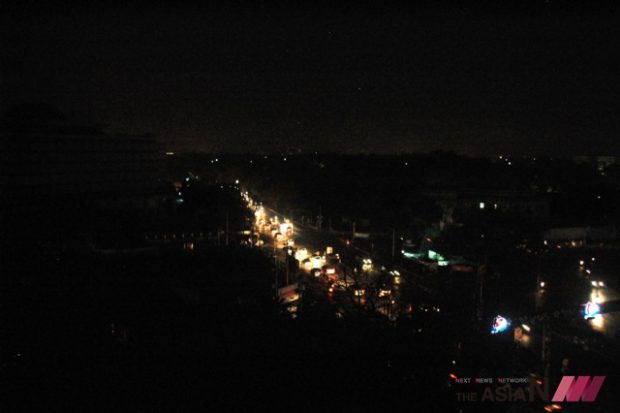Pakistan: Politics of Power for Power

Pakistani students study on candle light during a power cut in northwest Pakistan’s Peshawar, on April 3, 2012. Pakistan is facing a power shortfall of over 5,500MW per day, where some rural and urban areas have to endure blackout for 10 to 20 hours each day. (Photo : Xinhua/NEWSis)
With its ever growing citizen population, Pakistan has always struggled with the supply and demand of electricity. However, the problem was not so severe until the first decade of the 21st century when military dictator General Musharraf’s regime privatized the electric supply corporation, Karachi, and established distribution companies in various regions of the country, separating the distribution system to Water & Power Development Authority (WAPDA), allowing WAPDA to run the affairs on a commercial basis. But instead of increasing the competitive edge of corporations, difficulties arose with the supply of electricity.
The result was prolonged power cuts ranging from eight to eighteen hours in cities as well as rural areas across the country, the government, claiming that it was punishing citizens for not paying electricity bills and controlling electricity theft.
When the people decried such moves, the government came up with another excuse by revealing tables showing Pakistan’s wide gap between the supply and demand of electricity.
Unfortunately, the situation became violent as people started staging demonstrations, ransacking utility offices, and blocking roads and streets. This all continued for five years even during the administration of the Pakistan Peoples’ Party (PPP), a popular political party that came into power through the 2008 general elections, ousting Musharraf to be in power until 2013. The opposition party, Pakistan Muslim League, Nawaz (PML-N), led by sitting premier, Nawaz Sharif, which had succeeded to form government in only one province of Punjab, encouraged the agitating masses to take to the streets against “load shedding” which is what Pakistanis have come to call power cuts.
During this time, the country witnessed the politics of electricity power for coming into power, as the PPP leadership issued prolonged electricity shutdowns. The PPP government had nothing but to say that they inherited this issue from military dictator and were trying to resolve it.
The PPP had even gone so far as to hiring the services of a Turkish company that assembled floating power plants. A plant was anchored in the Arabian Sea near Karachi for a long time but did not deliver results. In the end, the PPP lost one of its premiers in a court order of a corruption case.
When the PPP announced the general elections that would be held in March 2013, at the end of its 5-year term, PML-N President Nawaz Sharif pledged with the nation during the election campaign that if elected, he would end load shedding within three months.
On Election Day, to the nation’s surprise, as soon as his victory became clear, Nawaz Sharif changed his promise saying, “It will take three years to end the crisis of electricity shortage”.
With no changes in the status quo, the people continued agitations against the government. And interestingly enough, the PPP, which had lost the polls in the 2013 election, began using the same issue of electricity to attack the ruling PML-N. Another emerging political party— Pakistan Tehreek-e-Insaf (PTI), led by former cricket captain Imran Khan—also raised the same issue of electricity supply during a campaign against PML-N instead of raising other issues such as poll rigging and massive corruption.
Prolonged power cuts and shortages became an issue of great weight. Not only did it present adverse effects on industrial and agricultural production, trade, and business, it left thousands of people without jobs. Power cuts occurred with greater frequency during the long and hot summer months. And each time they came, business and development grinded to a halt. This—along with poor prospects of employment, education, and health services—is the greatest concern of the average Pakistani. In fact, the power blackouts are longer in rural and poor urban areas. According to a survey conducted by a private firm, on average, around 53 percent of the citizen population goes without electricity for more than eight hours a day. Pakistanis have to pay some of the highest prices for electricity due to a rise in a series of annual hikes in energy costs.
In such a situation, a large number of growers and village people in rural areas have switched over to electric generators and solar power to run tube-wells for irrigating their farming lands and meeting other needs. Because of this change, generator and solar panel business has been thriving with each passing day.
Still, prospects were grim with angry mobs rampaging and assailing power companies in frustration at the long power cuts. Such incidents offered big opportunities for the PPP and PTI to turn their rage against the incumbent government PML-N by prematurely launching their campaign slogans for elections to be held in March 2018.
As PPP chairman, Bilawal Bhutto, son of slain premier Benazir Bhutto, intensified his crusade against the PML-N government pledging that his party would steer the country and masses out of its electricity crisis, Prime Minister Nawaz Sharif suddenly came out with a new “promise” to end load shedding by 2018 (same year of general elections).
Pakistan installed generating electricity to a capacity of 23,928 MW in 2015 through different sources including hydro power plants, gas and furnace oil power plants, and nuclear power plants. However, at one stage, hardly fifty percent of the energy could be produced against the total demand of 17000 MW. Currently, there is a shortfall of 5000 to 6000 MW of electricity despite having 18 hydroelectric and 12 thermal power plants—all run by State-owned Water and Power Development Authority. Besides this, 42 independent Power Producers (IPPs) produced a total of 11,612 MW by the end of 2016, but even so, the government could not overcome the crisis.
The successive governments had announced several projects of wind and solar power plants but none were functional for more than a decade. At least 11 wind power plants are located in Southern Sindh province, being Pakistan’s “wind corridor” and having the capacity to generate 21,143 MW, but their production is long in coming. Very recently, the government announced that 13 coal-fired power plants are being installed as part of the China-Pakistan Economic Corridor that would help rid Pakistan of its power crisis.
The world will see where the current Politics of Power for the Power will lead Pakistan in the years to come—and soon, with the 2018 elections.

































































